THE DIPTERA OF SUFFOLK PETER VINCENT
Introduction
The records that form this checklist are from the Watsonian vice-counties of East (v.c. 25) and West (v.c. 26) Suffolk which are of greater extent than the modern administrative county boundaries. Diptera are not well recorded in Suffolk, with few records of even quite common species. Therefore, although records are in the main collected at monad (O.S.1km square) or greater accuracy, in order to assess the relative abundance and distribution of a diptera species the hectad (O.S.10km square) is used as the base recording unit. Suffolk comprises of 54 hectads or part hectads.
In this checklist of Suffolk Diptera the arrangement of families follows as set out in Chandler (1998) and updates (Dipterists Forum, 2021). The classification of British diptera starts with the Lower Diptera (Nemotercera) followed by the Brachycera. Within families, all taxa are listed alphabetically. Altogether there are at present 107 families of diptera recognised within the British fauna, and the British Isles list of diptera currently (August 2021) runs to some 7224 species (of which 41 are recorded from Ireland only) (Chandler, 2021).
The layout of the checklist is that for each family the first division is by genus and then by species in alphabetical order. For most families, subfamilies and tribes are also recognised: and the genus can also be divided at subgenus level. For every individual species the species name (in bold type) is followed by the authority, then details of the first record of that species from Suffolk - place, date (with as much accuracy as possible) and recorder (where known). To give an indication of the distribution and the abundance of each species, this is followed by a list of all the hectads each species has occurred and the number of known records (in square brackets).
Part Four: Xylophagidae, Athericidae, Rhagionidae, Tabanidae, Xylomyidae, Stratiomyidae, Acroceridae, Bombyliidae, Therevidae, Scenopinidae, Asilidae. The first three parts of the checklist list all the known Suffolk species of the twentyfive families of the Lower Diptera suborder. Part Four starts the second suborder of Diptera, the Brachycera. The Brachycera contains the remaining six infraorders of the British diptera, a total of eighty one families. The first four infraorders; Xylophagomorpha, Tabanomorpha, Stratiomyomorpha and Asilomorpha, containing eleven families will be covered in Part Four. The Xylophagomorpha, Tabanomorpha and Stratiomyomorpha each comprises of one superfamily, namely Xylophagoidea, Tabanoidea and Stratiomyoidea, while the Asilomorpha comprises of two superfamilies, Nemestrinoidea and Asiloidea. In turn the Xylophagoidea contains one family, Xylophagidae. The Tabanoidea contains three families, Athericidae, Rhagionidae and Tabanidae, the Stratiomyoidea two families, Xylomyidae and Stratiomyidae. The Nemestrinoidea contains one family, Acroceridae and the Asiloidea contains four families, Bombyliidae, Therevidae, Scenopinidae and Asilidae.
Trans. Suffolk Nat. Soc. 57 (2021)
This group of dipteran families are sometimes referred to as the Larger Brachycera and are the families covered by the excellent identification and ecological guide, British Soldierflies and their Allies by Alan Stubbs and Martin Drake (Stubbs & Drake, 2001). They include some of the more familiar and best recorded flies on the Suffolk checklist.

The families Xylophagidae (awl flies) and Athericidae (water snipeflies), although not closely related, have very similar geographical distributions, and are found throughout Britain with the exception of East Anglia and parts of the East Midlands. Therefore there are no Suffolk records of flies of these families. Whereas, the Rhagionidae (snipeflies) are found throughout Britain. Several Rhagionid species are quite large and conspicuous flies, and others are unremarkable very small black flies. In appearance they have a conical abdomen, which is marked with yellow in some species, and with quite long slender legs that lack spines. There are 15 British species, six of which are found in Suffolk.
Commonly known as horseflies or clegs, Tabanidae are the largest of the bloodsucking insects in Britain; the larger species can have a body length of 15 mm and a wingspan of 35 mm. However, for an insect that has rather annoying habitats, they are at close inspection rather beautiful. In many species the colours and patterns of the eyes of a horsefly are extraordinary - iridescent coloured bands, or brilliant green, purple and bronze zig-zag patterns. Although Haematopota pluvialis (Linnaeus, 1758) the common grey cleg is still widespread, many species of horsefly have declined markedly over the past 100 years, probably mainly through loss of suitable breeding habitat in pastoral areas. Several species require old and relatively undamaged wetlands, and some have very specific requirements such as saltmarsh, coastal levels or base-poor mire and bog. Suffolk is fortunate to have retained many of these wetland habitats and the Tabanidae fauna of the county is relatively rich. Haematopota subcylindrica Pandellé, 1883 was graded Nationally Rare by the Natural England status review (Drake, 2017) and Atylotus latistriatus Brauer in Brauer & von Bergenstamm, 1880, H. bigoti Gobert, 1880, H. grandis Meigen, 1820, Hybomitra ciureai (Séguy, 1937), H. muehlfeldi (Brauer in Brauer & von Bergenstamm, 1880, and Tabanus maculicornis Zetterstedt, 1842 were graded Nationally Scarce. Of the 30 recognised British species 17 have been recorded from Suffolk.
Atylotus latistriatus
In appearance Xylomyidae (wood soldierflies) are similar in appearance to soldierflies, hence the name, but are in fact better described as mimics of solitary wasps and sawflies, although the antennae are much shorter than that of a wasp or sawfly. Of the three British species, only one is at all common; indeed one species has
Trans. Suffolk Nat. Soc. 57 (2021)
not been seen for 150 years and may not in fact be British at all. The sole Suffolk species Solva marginata (Meigen, 1820) is found quite widely in the county in wetland areas with willow or poplar trees.
The Stratiomyidae are known as soldierflies; the name relating to the similarity between the appearance of this brightly coloured family of flies and the gaudy uniforms soldier wore on ceremonial parades. Though many soldierflies are distinctly patterned, some are metallic green and others black. Soldierflies can be roughly divided into species with aquatic larvae and species with terrestrial larvae. Both types of larvae feed on decaying plant material. Some species live in stagnant water, others in flowing. There are also some salt-loving species. There are 48 British species making this the largest family in the Larger Brachycera, of which 41 have been recorded from Suffolk. Amongst the species still known to be present in the county, Oxycera leonina (Panzer, 1798) categorised as Nationally Rare Odontomyia argentata (Fabricius, 1794), O. ornata (Meigen, 1822) and Stratiomys longicornis (Scopoli, 1763) (see Cover as Nationally Scarce (Drake, 2017). The very striking soldierfly S. chamaeleon (Linnaeus, 1758), nationally a very rare fly, has not reliably be seen in the county since 1953 at Redgrave Fen, prior to water abstraction.
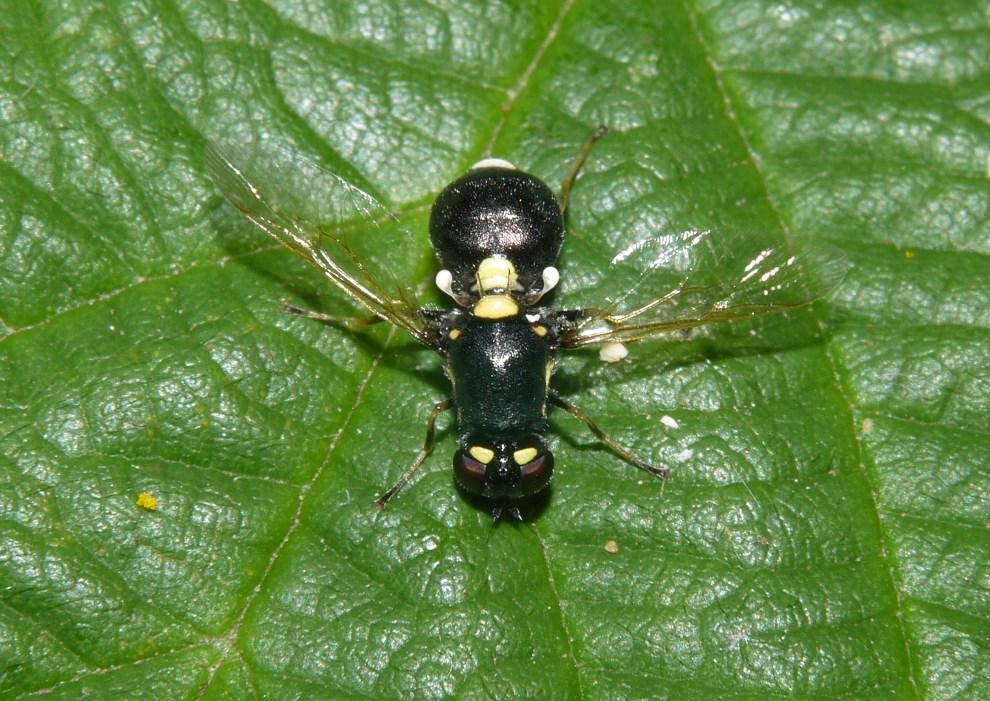
Acroceridae or hunchback flies are curiously shaped flies; they are easily recognised by their fat dumpy shape with a hunchback, very large squamae and pale coloured abdominal markings - a combination of features unique in the British fauna. They are also one of the few parasitoids of living spiders, with the suggestion that their strange body shape is that of a spider mimic. There are three British species of which two have been found in Suffolk, though there is only one record of Ogcodes gibbosus Latreille, 1796 by G. H. Verrall at Barnby Broad in 1900.
Bombyliidae are the bee flies, so called because of their similarity to small furry bees of which most species are parasitoids. The familiar Bombylius major Linnaeus, 1758 is a typical bee fly with large furry body, long proboscis and is characterised by the dark chocolatebrown margin to the wing. B. major is found throughout Suffolk from a variety of habitats including gardens and has the distinction of being the most recorded Suffolk fly with over 700 records from 46 of the 54 hectads or part hectads.
Trans. Suffolk Nat. Soc. 57 (2021)
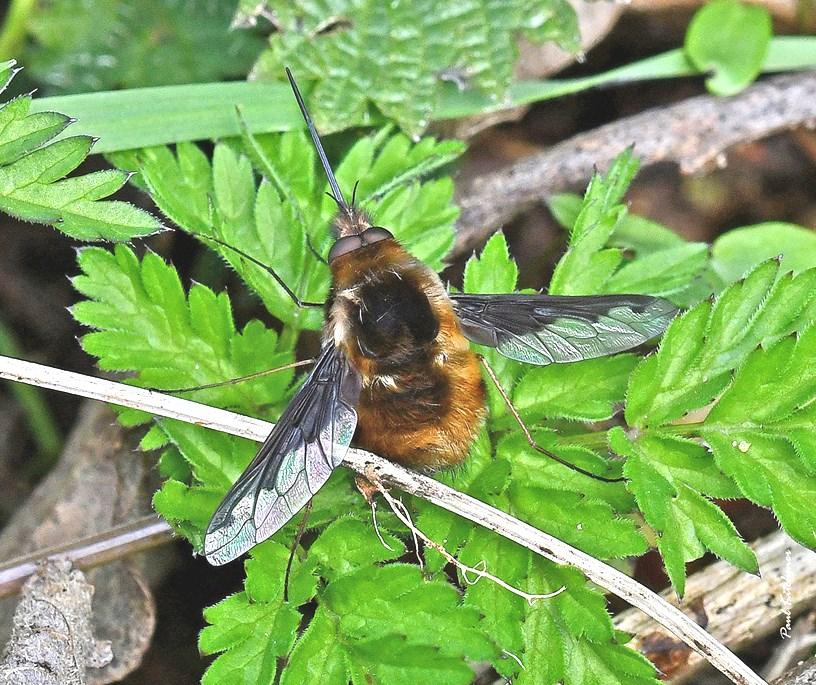
Suffolk Natural History,
Vol.
The appearance of Therevidae are relatively distinctive with a narrow pointed abdomen, likened to a stiletto, hence their common name of stiletto flies. Graded Endangered by Drake (2017) Thereva strigata (Fabricius, 1794), is one of Britain’s rarest stiletto flies with records confined to a few sites on the southern English coast, however, there is a Suffolk record by Mike Edwards from Minsmere in 1996. Of the 14 British species, five have been recorded from Suffolk.

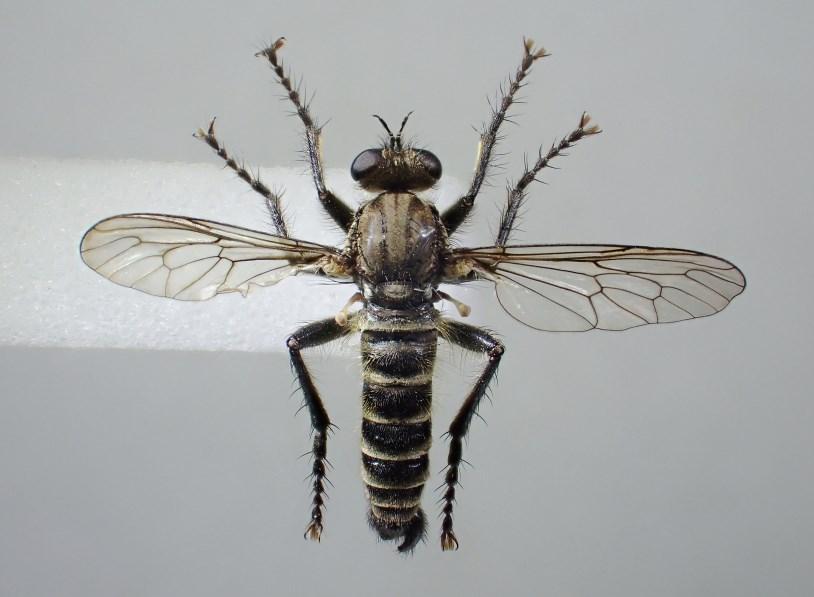
Scenopinidae are commonly known as window flies. As the most frequently encountered member of this family, Scenopinus fenestralis (Linnaeus, 1758) is a fairly strongly synanthropic species, characteristically, as the common family name suggests, found on windows. However, even this species appears to be very rare nowadays and the other British species S. niger (De Geer, 1776) has not been recorded in the Suffolk since the 19th century.
Asilidae are elongate, often powerfully built, predatory flies with piercing mouthparts. They are usually observed sitting on foliage, logs, tree trunks or the ground, from which they dart out rapidly to catch prey, hence their common name of
Lasiopogon cinctus
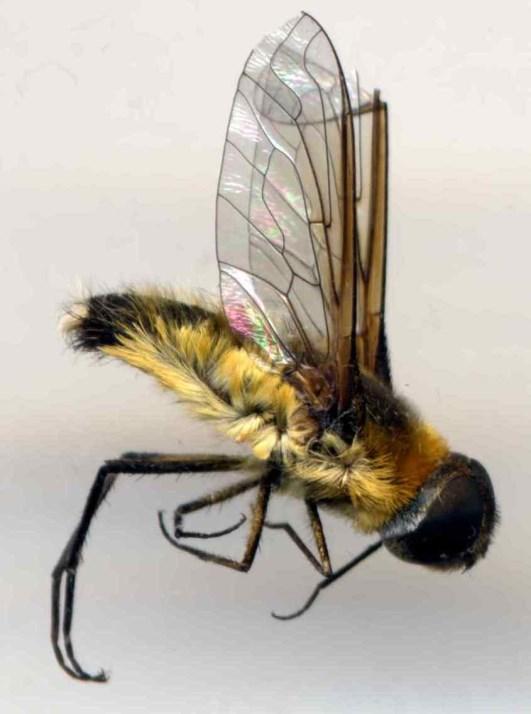
robberflies. However, the very slender Leptogaster species hover slowly among herbage in search of prey and undertake an ambush directly from such flight. The only British records of Machimus arthriticus (Zeller, 1840) are confined to Breckland where it is known from a tight cluster of records centred on The King’s Forest south of Thetford, with three other records within 20 km to the north. It is categorised as Nationally Rare by Drake (2017), with the Suffolk robberflies Dioctria oelandica (Linnaeus, 1758) Eutolmus rufibarbis (Meigen, 1820) and Lasiopogon cinctus (Fabricius, 1781) graded as Nationally Scarce.
Britain’s largest and most colourful robberfly Asilus crabroniformis Linnaeus, 1758 is a rather scarce and localised species associated with assorted grazed habitats. Once thought to be rare, it was stripped of its Nationally Scarce status by Drake (2017), because it is not as scarce as previously thought. It is an impressive insect; body 28 mm in length, with a hornet-like colour scheme comprising of a brown thorax and black and yellow abdomen. There are a number of historical Suffolk records, but it does not seem to have been reliably recorded since 1955. There are 29 British species of Asilidae, 19 of which have been recorded from Suffolk.
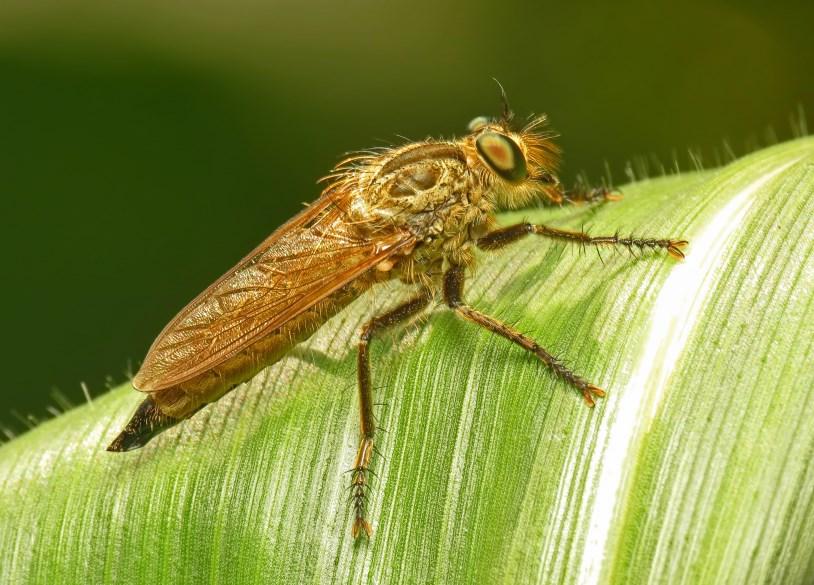
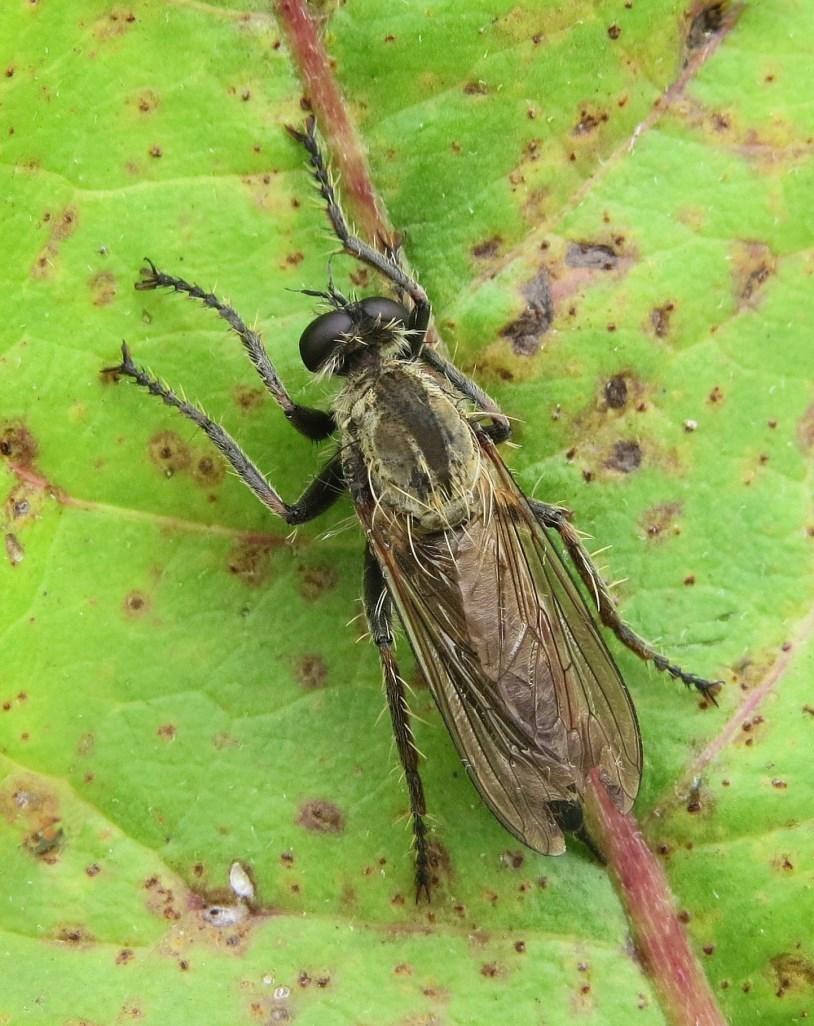
Records for this section of the checklist come mainly from Suffolk Biodiversity Information Service (SBIS), and the National Biodiversity Network (NBN), with historical records from the Transactions of the Norfolk & Norwich Naturalists’ Society (Morley & Atmore, 1915) and the Transactions of the Suffolk Naturalists’ Society (Morley, 1949-1951; Hubbard, 1995 and 2000). Other records were obtained from, Laurence (1997) and Stubbs (1998).
A few records have been italicised; these records whether for, rarity, location, habitat, or date are considered doubtful. These records have been maintained in the checklist until further checks can be done on any possible voucher specimens to support the record. These records have not been included in the species totals.
Trans. Suffolk Nat. Soc. 57 (2021)
References
Chandler, P. J. (ed.) (1998). Checklists of Insects of the British Isles (New Series). Part 1; Diptera. Handbooks for the Identification of British Insects 12(1): 1-234.
Chandler, P. J. (2021). Corrections and Changes to the Diptera Checklist (46). Dipterists Digest (Second Series) 28: 252.
Dipterists Forum. (2021). An Update of the 1998 Checklist of Diptera of the British Isles Dipterists Forum [online] http://www. dipterists.org.uk/checklist/ [Accessed 9 October 2021]
Drake, C. M. (2017). A review of the status of Larger Brachycera flies of Great BritainSpecies Status No.29. Natural England Commissioned Reports, Number 192.
Hubbard, A. C. (1995). Suffolk Robber Flies (Asilidae). Trans. Suffolk Nat. Soc. 32: 3234.
Hubbard, A. C. (2000). Recent records of some notable and rare Diptera from Suffolk. Trans. Suffolk Nat. Soc. 36: 76-80.
Laurence, B.R. (1997). Flies from ancient coppiced woodland in Suffolk Dipterists Digest (Second Series) 4: 78-91.
Morley, C. & Atmore, E. A. (1915). The Diptera of Norfolk and Suffolk. Transactions of the Norfolk & Norwich Naturalists’ Society 10: 1-180.
Morley, C. (1949-1951). The Diptera of Suffolk. Family xvi Stratiomyidae Trans. Suffolk Nat. Soc. 7 (1): 11-14.
Morley, C. (1949-1951). The Diptera of Suffolk. Families xvii-xxii Trans. Suffolk Nat. Soc. 7 (2): 58-63.
Stubbs, A. (1998). The occurrence of the soldierfly Oxycera leonina (Panzer) (Diptera, Stratiomyidae) in Norfolk and Suffolk Dipterists Digest (Second Series) 5: 77-79.
Stubbs, A. & Drake, C. M. (2001). British Soldierflies and their Allies. Reading, British Entomological and Natural History Society.
Suffolk Diptera Checklist (Part Four)
RHAGIONIDAE
CHRYSOPILUS Macquart, 1826 asiliformis (Preyssler, 1791) - Monk Soham, 12 August 1917, C. Morley TL 68,77,78,84,86,88 TM 05,07,14,26,34,46,47.49 [31] cristatus (Fabricius, 1775) - Foxhall, Ipswich, 1893, C. Morley TL 84,85,86,88,94,95,97 TM 03,05,07,14,15,17,24,25,26,27,28,33,34,35,36,45,46,47,48,49,57,58,59 [159] laetus Zetterstedt, 1842 - Thetford, 9 July 2018, A. Musgrove TL 88 [1]
RHAGIO Fabricius, 1775 lineola Fabricius, 1794 - Bentley Woods. 1895, C. Morley TL 67,77,78,86,87,88,95 TM 07,13,14,15,25,45,46,47,49,58 [66] scolopaceus (Linnaeus, 1758) - Monk Soham, pre 1915, C. Morley TL 68,77,78,84, 86,87,88,94,95,97 TM 03,04,05,07,13,14,15,24,25,28,33,34,35,45,46,47,48,59 [103] tringarius (Linnaeus, 1758) - Ipswich, 1893, C. Morley TL 78,87,88,95,96,97 TM 05,07,25,27,34,37,46,47,48,49 [31]
Trans. Suffolk Nat. Soc. 57 (2021)
TABANIDAE
CHRYSOPSINAE
Chrysopsini
CHRYSOPS Meigen, 1803
Subgenus CHRYSOPS sensu stricto caecutiens (Linnaeus, 1758) - Tostock, 20 July 1900, W.P. Rees TL 66,78,93,94,95,97 TM 03,04,07,13,14,15,24,25,26,35,46,47 [41] relictus Meigen, 1820 - Lowestoft, 13 August 1898, C. Morley TL 68,77,78,87,93,94,97, TM 03,13,15,27,34,35,47,49,57,58,59 [64] viduatus (Fabricius, 1794) - Walberswick, 1981, M. Hadley TL 97 TM 07,46,47,48 [56]
TABANINAE
Haematopotini
HAEMATOPOTA Meigen, 1803 bigoti Gobert, 1880 - Chillesford, 12 July 1908, G.H. Verrall TL 84 TM 13,35,45 [5] crassicornis Wahlberg, 1848 - Felixstowe, 1896, C. Morley TL 78,84,97 TM 07,13,14,17,33,34,46,47,59 [35] grandis Meigen, 1820 - Woodbridge, 31 August 1907, C. Morley TM 24,34,35,38,45,46,47,48,57 [28] pluvialis (Linnaeus, 1758) - Ipswich, 11 June 1897, C. Morley TL 68,77,78, 88,93,94,95,97 TM 03,05,07,14,15,25,27,28,35,36,38,39,45,46,47,48,49,58,59 [129] subcylindrica Pandellé, 1883 - Minsmere, 2 July 2001, M. Edwards TM 46 [2] Tabanini
ATYLOTUS Osten Sacken, 1876 fulvus (Meigen, 1804) - Belton, 1834, Paget TG 40 [1] no recent records latistriatus Brauer in Brauer & von Bergenstamm, 1880 - Flatford Mill, 23 July 1995, A. C. Hubbard TM 03,08,12,13,34 [9]
HYBOMITRA Enderlein, 1922 bimaculata (Macquart, 1826) - Bentley Woods, 1893, C. Morley TL 78,87,93,94 TM 03,07,13,24,34, 45,46,47,58 [37] ciureai (Séguy, 1937) - Barnby Broad, 12 July 1900, C. Morley TM 46,47,48,57 [31] distinguenda (Verrall, 1909) - Great Glenham, c1860, E.N. Bloomfield TL 85,94,97 TM 07,13,24,25,34,36,46,47,48 [28] muehlfeldi (Brauer in Brauer & von Bergenstamm, 1880) - Leiston, 4 August 1998, Natural England TM 46 [1]
TABANUS Linnaeus, 1758
autumnalis Linnaeus, 1761 - Southwold, July 1900, C. Pyett TG 40 TL 78 TM03,04,13,14,25,26,34,37,44,46,47,49,57 [41] bromius Linnaeus, 1758 - Felixstowe, 1903, A.E. Gibbs TL 93 TM 03,15,26,37,39,46 [16] maculicornis Zetterstedt, 1842 - Assington, 1916, B. Harwood TL 93,97 TM 07,46 [9] miki Brauer in Brauer & von Bergenstamm, 1880 - Market Weston, 13 July 2003, Royal Horticultural Society TL 97 [1]
Trans. Suffolk Nat. Soc. 57 (2021)
XYLOMYIDAE
SOLVA Walker, 1860 marginata (Meigen, 1820) - Exning, 11 August 1882, G.H. Verrall TL 66,77,86,87 TM 13,14,15,24,34,46 [11]
STRATIOMYIDAE
BERIDINAE
BERIS Latreille, 1802 chalybata (Forster, 1771) - Ipswich, 14 March 1900, C. Morley TL 66,77,78,84,95,97,98 TM 05,07,13,14,24,27,28,36,46,47 [39] clavipes (Linnaeus, 1767) - Little Cornard, 9 June 1915, B. Harwood TL 66,83 TM 07,46,47,48 [18] geniculata Haliday in Curtis, 1830 - Fritton, 11 May 1939, C. Morley TM 03,07,47,49,58 [8] morrisii Dale, 1841 - Monk Soham, 15 June 1921, C. Morley TL 96 TM 03,26,46,47 [9] vallata (Forster, 1771) - Theberton Marshes, 10 July 1900, C. Morley TL 67,68,76, 77,78,86,97 TM 03,05,07,14,26,27,28,34,35,36,39,46,47,48,49,58,59 [85]
CHORISOPS Rondani, 1856 nagatomii Rozkošný, 1979 - Brandon, 15 August 1983, A.A. Allen TL 78,86,87 TM 14,24 [6] tibialis (Meigen, 1820) - Monk Soham, 5 August 1918, C. Morley TL 67,77,78.87,95 TM 07,13,14,24,25,27,34,46,47,49,59 [51]
NEMOTELINAE
NEMOTELUS Geoffroy, 1762
Subgenus CAMPTOPELTA Williston, 1917 nigrinus Fallén, 1817 - Knettishall, July 1941, C. Morley TL 68,77,78,97,98 TM 07,39,46,47,48,49,59 [27]
Subgenus NEMOTELUS sensu stricto notatus Zetterstedt, 1842 - Felixstowe, no date given, C. Morley TM 13,34,44,45,46,47,57 [52] pantherinus (Linnaeus, 1758) - West Stow, no date given, C.G. Nurse TL 68,78,86,87,94,97,98 TM 07,34,36,46,47,49,58,59 [55] uliginosus (Linnaeus, 1767) - Ipswich, no date given, C. Morley TM 14,33,34,35,44,45,46,47.58,59 [45]
PACHYGASTRINAE
PACHYGASTER Meigen, 1803 atra (Panzer, 1798) - Tostock, 1900, W.H. Tuck TL 67,77,78,84,86,96,97 TM 07,13,14,16,25,26,27,39,46,47,49 [65] leachii Stephens in Curtis, 1824 - Orford, 1908, E.N. Bloomfield TL 67,77,87 TM 07,13,14,24,35,45,46,47 [38]
ZABRACHIA Coquillett, 1901 tenella (Jaennicke, 1866) - West Stow, 1 March 1991- 30 April 1991, Natural England TL 78,87 [2]
Trans. Suffolk Nat. Soc. 57 (2021)
SARGINAE
CHLOROMYIA Duncan, 1837 formosa (Scopoli, 1763) - Monk Soham,15 May 1916, C. Morley TL 67,68,77,78,86,87,88,94,95,96,97,98 TM 03,04,05,07,13,14,15,23,24,25,26,27,28,35,36,38,44,45,46,47,48,58,59 [190]
MICROCHRYSA Loew, 1855
cyaneiventris (Zetterstedt, 1842 - Orford, 1908, J.J.F.X. King TM 03,26,35,47 [4] flavicornis (Meigen, 1822) - Newmarket, no date given, G.H. Verrall TL 66,97 TM 07,13,37,46,47,59 [10] polita (Linnaeus, 1758) - Monk Soham, 2 August 1912, C. Morley TL 77,78,94 TM 03,05,07,13,14,23,24,25,26,27,46,47,58 [40]
SARGUS Fabricius, 1798
GEOSARGUS Bezzi, 1907 bipunctatus (Scopoli, 1763) - Cavenham Heath, 22 September 1992, R. Key TL 67,76,77,94 TM 04,13,14,17,24,25,35,46,47,49 [51] cuprarius (Linnaeus, 1758) - Hopton Fen, 3 August 1996, I. Perry TL 98 [2] flavipes Meigen, 1822 - Beccles, 25 August 1898, C. Morley TG 40 TM 45,46,47,49 [13] iridatus (Scopoli, 1763) - Tostock, 1899, W.H. Tuck TL 95,96 TM 14,46,47,49 [10]
STRATIOMYINAE
Oxycerini
OXYCERA Meigen, 1803 analis Wiedemann in Meigen, 1822 - Crettingham, 6 June 1943, P.J. Burton TM 26 [1] no recent records fallenii Staeger, 1844 - Walberswick, 7 July 1987, P.F. Entwistle TL 93 TM 47 [2] leonina (Panzer, 1798) - Gromford, 27 July 1997, A, Stubbs TM 34,35 [4] morrisii Curtis, 1833 - Flatford, 9 May 1951, J.E. Collin TL 86,97 TM 03,47 [6] nigricornis Olivier, 1811 - Foxhall, 10 August 1902, C. Morley TL 97 TM 13,34,44,45,46,47,57 [52] pardalina Meigen, 1822 - Redgrave Fen, 23 June 2009, A. Godfrey TM 07 [1] pygmaea (Fallén, 1817) - Tuddenham Fen, 29 July 1880, G.H. Verrall TL 77,97 [5] rara (Scopoli, 1763) - Foxhall, 10 August 1902, C. Morley TL 84,87,94,97 TM 07,13,14,17,24,26,35,46,47,48,49,57,58 [41] trilineata (Linnaeus, 1767) - Felixstowe, August 1896, A. Piffard TG 40 TL 94,97 TM 05,07,25,27,28,46,47,48,49,58,59 [39]
VANOYIA Villeneuve, 1908 tenuicornis (Macquart, 1834) - Orford, 7 July 1908, J.J.F.X. King TL 86,97 TM 44,46,47,48,58,59 [38]
Stratiomyini
ODONTOMYIA Meigen, 1803 angulata (Panzer, 1798) - Tuddenham Fen, 29 July 1880, G.H. Verrall TL 77 [1] no recent records
Trans. Suffolk Nat. Soc. 57 (2021)
Suffolk Natural History, Vol. 57
argentata (Fabricius, 1794) - Mildenhall, 18 May 1908, J.W. Yerbury TL 77,78,86,87,97 TM 16,26,35,36,42,46,47.49 [40]
ornata (Meigen, 1822) - Monk Soham, 14 June 1947, C. Morley TL 78 TM 46,47,48,59 [20] tigrina (Fabricius, 1775) - Tuddenham Fen, 20 July 1880, G.H. Verrall TL 68,77,78,86,96,97 TM 07,13,17,25,26,36,37,46,48,49,59 [40]
OPLODONTHA Rondani, 1863 viridula (Fabricius, 1775) - Felixstowe, 1898, C. Morley TG 40 TL 68.77,78,86,94,97,98, TM 07,14,24,34,35,37,46,48,59 [114]
STRATIOMYS Geoffroy, 1762 chamaeleon (Linnaeus, 1758) - Letheringham, 6 August 1918, E.A. Elliot TM 07,25 [3] longicornis (Scopoli, 1763) - Wherstead, 5 June 1897, C. Morley TL 87,96 TM 14,34,44,46,47 [17]
potamida Meigen, 1822 - Barnby Broad, 1898, C. Morley TL 76,77,78,86,87,94,97 TM 04,05,07,14,26,27,34,45,46,47,49 [57]
singularior (Harris, 1776) - Bawdsey, 7 July 1894, G.H. Verrall TL 62,68,98 TM 07,24,32,33,34,35,44,46,47,57,58,59 [48]
ACROCERIDAE
ACROCERA Meigen, 1803 orbiculus (Fabricius, 1787) - Tuddenham Fen, July 1903, C. Morley TL 77 TM 03,47 [7]
OGCODES Latreille, 1796 gibbosus (Linnaeus, 1758) - Barnby Broad, 12 July 1900, G.H. Verrall TM 48 [1] no recent records
BOMBYLIIDAE
BOMBYLIINAE
BOMBYLIUS Linnaeus, 1758 canescens Mikan, 1796 - Tostock, 1897, W.H. Tuck TL 96 [1] no recent records discolor Mikan, 1796 - Newmarket, 8 April 1898, G.H. Verrall TL 66,84 TM 03,13,26,35,36 [9] no recent records major Linnaeus, 1758 - Sudbury, 1916, B. Harwood TG 50 TL 64,66,68,74,75,76, 77,78,84,86,87,88,93,94,95,96,97,98 TM 03,04,05,07,13,14,15,17,23,24,25,26,27, 28,33,34,35,36,38,39,45,46,47,48,49,57,58,59 [721]
VILLA Lioy, 1864 cingulata (Meigen, 1804) - Leiston Abbey, 25 July 1899, C. Morley TM 46 [1] no recent records modesta (Meigen, 1820) - Covehithe, July 1822, J. Curtis TL 77 TM 33,45,46,57,58,59 [21] venusta (Meigen, 1820) - Tuddenham Fen, 29 August 1902, C. Morley TL 77 [1] no recent records
PHTHIRIINAE
PHTHIRIA Meigen, 1803 pulicaria (Mikan, 1796) - Covehithe, July 1882, J. Curtis TL 77,78 TM 59 [5]
THEREVIDAE
THEREVINAE
ACROSATHE Irwin & Lyneborg, 1981 annulata (Fabricius, 1805) - Barton Mills, no date given, G.H. Verrall TL 77,78 TM 46,47,58,59 [22]
THEREVA Latreille, 1796 bipunctata Meigen, 1820 - Brandon, 24 July 1906, E.A. Elliot TL 77,78,87,88 TM 13,24,35,44,45,46,47,58,59 [43] nobilitata (Fabricius, 1775) - Sudbourne, 1907, G.H. Verrall TL 67,77,78,87,88 TM 05,07,13,14,23,24,27,35,45,46,47,58,59 [98] plebeja (Linnaeus, 1758) - Trimley, 17 June 1898, C. Morley TL 77,87 TM 05,07,23,34,36,47,59 [11] strigata (Fabricius, 1794) - Minsmere, 25 April 1996, M. Edwards TM 46 [1]
SCENOPINIDAE
SCENOPINUS Latreille, 1802 fenestralis (Linnaeus, 1758) - Newmarket, 3 August 1901, G.H. Verrall Tl 66 TM 13,26,46,47 [11] niger (De Geer, 1776) - Tostock, May 1898, W.H. Tuck TL 86,96 [3] no recent records
ASILIDAE
ASILINAE
ASILUS Linnaeus, 1758 crabroniformis Linnaeus, 1758 - Bentley Woods, 1895, C. Morley TL 66,93,96 TM 03,13 [7] no records since 1955
DYSMACHUS Loew, 1860 trigonus (Meigen, 1804) - Lowestoft, 1881, G.H. Verrall TG 50 TL 67,76,77,78,87,88 TM 03,07,14,23,24,33,34,35,45,46,47,57,58,59 [112]
EUTOLMUS Loew, 1848 rufibarbis (Meigen, 1820) - Tangham Forest, Capel St Andrew, August 1907, J.E. Collin TL 67,73,77,78,87,88,95,97,98 TM 07,14,24,28,30,34,35,46,47,57 [99]
MACHIMUS Loew, 1849
arthriticus (Zeller, 1840) - Barnham, 22 June 1996, J. Cole TL 87,88 [7] atricapillus (Fallén, 1814) - Bentley Woods, 1894, C. Morley TL 67,77,78,87,88,96,98 TM 07,14,17,24,25,35,45,46,47 [74] cingulatus (Fabricius, 1781) - Blythburgh Wood, 12 September 1939, C. Morley TL 67,77,78,86,88,98 TM 07,14,15,24,25,35,37,46,47 [62] rusticus (Meigen, 1820) - Brandon, 26 August 1906, C. Morley TL 78 [1] no recent records
Trans. Suffolk Nat. Soc. 57 (2021)
NEOITAMUS Osten Sacken, 1878 cothurnatus (Meigen, 1820) - Bentley Woods, 16 May 1896, C. Morley TM 13 [1] no recent records cyanurus (Loew, 1849) - Bentley Woods, 1894, C. Morley TL 77,87,88,95,97 TM 03,07,14,24,25,45,46,47,48 [54]
PHILONICUS Loew, 1849 albiceps (Meigen, 1820) - Lowestoft, 1898, C. Morley TM 14,45,46,47,58 [23]
DASYPOGONINAE)
Isopogonini
LEPTARTHRUS Stephens, 1829 brevirostris (Meigen, 1804) - Newmarket, 8 June 1905, J.E. Collin TL 66,77 [2]
LAPHRIINAE
CHOERADES Walker, 1851 marginatus (Linnaeus, 1758) - Bentley Woods, 1893, C. Morley TL 77,86,87,95,96 TM 07,13,15,24,47 [13]
LEPTOGASTRINAE
LEPTOGASTER Meigen, 1803 cylindrica (De Geer, 1776) - Monk Soham, 1922, C. Morley TL 76,77,78,86,87, 88,95,97 TM 03,05,07,13,14,15,26,27,28,35,36,38,39,44,46,47,49 [79] guttiventris Zetterstedt, 1842 - Tuddenham Fen, 10 August 1928, C. Morley TL 77,84,87,88 TM 46 [7]
STENOPOGONINAE
Dioctriini
DIOCTRIA Meigen, 1803 Subgenus DIOCTRIA sensu stricto atricapilla Meigen, 1804 - Wortham Marshes, 9 June 1900, C. Morley TG 40 TL 77,78,84,86,87,96,97 TM 03,05,07,13,14,15,26,28,34,35,37,47,48 [43] baumhaueri Meigen, 1820 - Newmarket, no date given, G.H. Verrall TL 66,77,78,86,88,95,96 TM 07,13,14,15,23,24,25,34,35,45,46,47,57 [58] linearis (Fabricius, 1787) - Assington, July 1902, C. Morley TL 77,86,93,95,96 TM 15,25,27,46,47 [12]
oelandica (Linnaeus, 1758) - Bentley Woods, 1893, C. Morley TL 78.85,87,88,93 TM 13 [10] rufipes (De Geer, 1776) - Claydon, 11 June 1897, C. Morley TL 77,78,87,88,96 TM 03,05,07.14,15,23,24,27,34,35,44,46,47 [45]
Stichopogonini
LASIOPOGON Loew, 1847 cinctus (Fabricius, 1781) - Culford, 22 May 1924, C.G. Nurse TL 77,78,85,87,88,96 TM 33,34,35,46,47 [29]
Peter Vincent
Pennyfields, Rectory Road, Middleton, Suffolk IP17 3NW
Trans. Suffolk Nat. Soc. 57 (2021)
DIPTERA REPORT 2021 PETER VINCENT
Hoverflies are probably the family of flies that are most familiar to the general naturalist. Their appeal lies in the fact that apart from being in the most part rather attractive insects they are frequently encountered in gardens and urban areas as well as in the countryside. They may not garner as much attention as butterflies, moths or dragonflies, but the current interest in pollinators means they have been gaining a higher profile than once was the case. Some recorders are just happy to recognise the commoner and more obvious species without taking specimens, while there are plenty of taxonomic challenges for those who wish to take their interest a stage further. Indeed, for many an interest in hoverflies is a stepping stone to further study of the fascinating world of dipterology. Nowadays the study of hoverflies is much aided by the excellent, field guide by Ball & Morris (2015), and identification keys provided by Stubbs & Drake (1996). The Dipterists Forum Hoverfly Recording Scheme host a Facebook group, which as well as providing a simple way of adding records to the recording scheme database, means that photographic images of hoverflies can be posted online allowing identifications to be made or confirmed.
Although, hoverflies are the most studied and recorded family of flies in Suffolk, with about 180 of the 280 British species known from the county, new species continue to be added to the Suffolk checklist. These can be of species that have recently arrived in the country by natural migration from continental Europe or by accidental introductions, or they can be hoverflies that are considered long standing native British species - but because of their rarity have previously not been seen in the county. In the past year I have been made aware of two species of hoverfly that are new to Suffolk; one is a relatively recent arrival into Britain, probably brought in with imported plants, and the other a scarce native hoverfly hitherto not recorded from Suffolk.
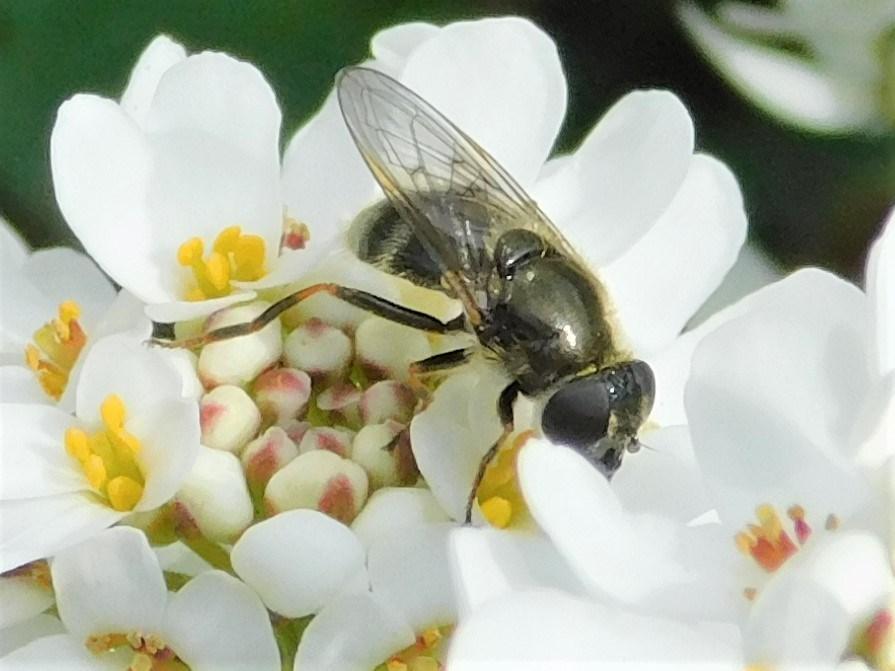
During the summer Paul Oldfield sent me a record of Cheilosia caerulescens (Meigen, 1822) which he had photographed in his garden in Felixstowe. At the time this was thought to be the first record of this species from Suffolk, but the SBIS database has an earlier 2020 record by Allan King from his Ipswich garden.
C. caerulescens is a recent British colonist that was first recorded in 2006 from Surrey (Collins & Halstead, 2008). Following the records from Surrey and another group of sightings in Bedfordshire (probably a case of multiple introduction) C. caerulescens has spread widely across southern England and as far north as Derbyshire. The larvae mine the leaves of non-native houseleeks, mainly Sempervivium tectorum L. but Cheilosia caerulescens
Trans. Suffolk Nat. Soc. 57 (2021)
also S. montanum L. and S. arachnoideum L. It is presumed that the fly was introduced accidentally with imported plants, probably from the Netherlands where C. caerulescens is well established (Ball. et al., 2011). It is relatively easy to identify, being a medium-sized, bare-eyed, bluish-grey Cheilosia with pale knees and distinct markings over the two cross veins of the wings. The lower face is rather strongly protruding, the third antennal segment is brownish-red, and the antennal pits are fused. C. caerulescens appears to be bivoltine as adults can be found both in late spring and in late summer-early autumn. The other hoverfly new to Suffolk, a rare native, is Meligramma euchromum (Kowarz, 1885). It is early flying, and perhaps has been overlooked amongst similar looking hoverflies. It was found by Adrian Knowles in Raydon Great Wood in April (see elsewhere in these Transactions).
In addition to species mentioned above, some interesting and uncommon species that have recently been recorded from Suffolk include, the Agromyzids, Chromatomyia milii (Kaltenbach, 1864), Agromyza cinerascens Macquart, 1835, and Liriomyza flaveola (Fallén, 1823), the Anthomyiid, Pegomya transgressa (Zetterstedt, 1846), the Chironomid, Synendotendipes impar (Walker, 1856) [1st Suffolk record], the Chloropid, Calamoncosis glyceriae Nartshuk, 1958, the Dixid, Dixa submaculata Edwards, 1920 [2nd Suffolk record], the Empidids, Hilara flavipes Meigen, 1822, H. litorea (Fallén, 1816), Kowarzia bipunctata (Haliday, 1833), Rhamphomyia tibiella Zetterstedt, 1842, and R. variabilis (Fallén, 1816), the Hybotid, Drapetis exilis Meigen, 1822, the Limoniids, Lipsothrix remota (Walker, 1848), and Tasiocera murina (Meigen, 1818). the Muscids, Phaonia fuscata (Fallén, 1825) and Spilogona denigrata (Meigen, 1826), the Pediciid Dicranota pavida (Haliday, 1833) [2nd Suffolk record, the first since 1928], the Piophilid, Stearibia nigriceps (Meigen, 1826), the Platypezid, Agathomyia viduella (Zetterstedt, [1838]) the Psychodid, Boreoclytocerus ocellaris (Meigen, 1804), the Sarcophagid, Sarcophaga anaces Meigen, 1826, the Syrphid, Triglyphus primus Loew, 1840, the Tachinids, Huebneria affinis (Fallén, 1810), Loewia foeda (Meigen, 1824), and Panzeria rudis (Fallén, 1810), the Tephritid, Tephritis praecox (Loew, 1844), and the Ulidiidae, Dorycera graminum (Fabricius, 1794).
References
Ball, S.G., Morris, R.K.A, Rotheray, G.E. & Watt, K.R. (2011). Atlas of the Hoverflies of Great Britain (Diptera, Syrphidae). Wallingford, Biological Records Centre. Ball, S.G. & Morris, R.K.A (2015). Britain’s Hoverflies: A Field Guide. 2nd Ed. Woodstock, Oxfordshire, Princeton University Press. Collins, G.A & Halstead, A.J. (2008). Cheilosia caerulescens (Meigen, 1822) (Diptera, Syrphidae) new to Britain. Dipterists Digest (second series) 15: 23-26.
Peter Vincent
Pennyfields, Rectory Road, Middleton, Suffolk IP17 3NW
Trans. Suffolk Nat. Soc. 57 (2021)
